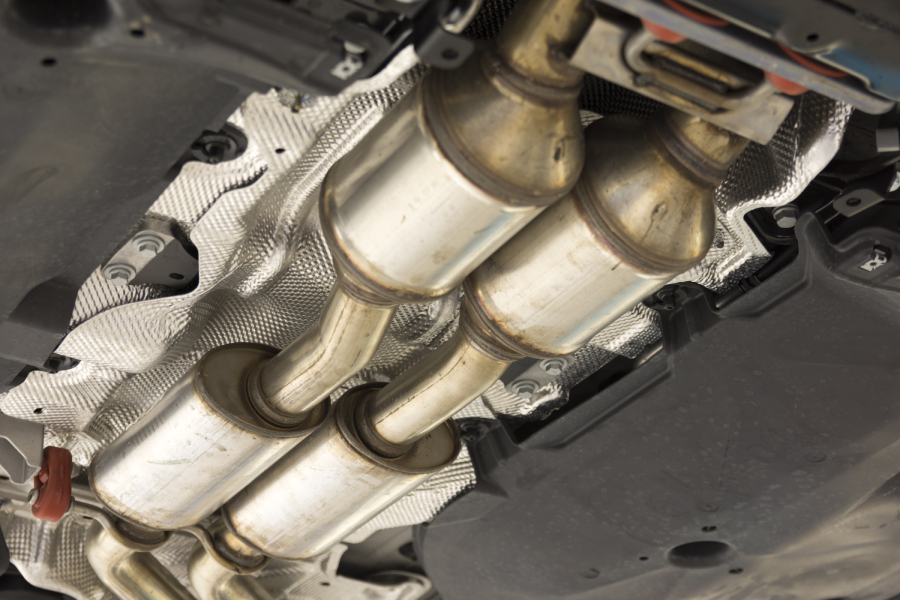An exhaust inspection is such a simple, yet extremely critical service. This most necessary maintenance is important to make sure your exhaust system is functioning flawlessly, properly controlling emissions and not releasing harmful gases and substances. It is also required to make sure your vehicle will pass an emissions test. This inspection includes a visual examination from the exhaust manifold all the way to the tailpipe. All in-between parts, including the pipes, catalytic converter and muffler, are thoroughly inspected. Your engine goes through four phases in a typical four-stroke combustion engine: intake, compression, combustion, and exhaust. The intake valve opens during the intake stroke, while the piston moves down, and allows gas and air to mix in the engine. The piston moves back up to compress the fuel/air mixture in the compression stroke. Your engine’s spark plug ignites the fuel/air mixture in the combustion stroke, while the piston moves down. Finally, the piston moves back up during the exhaust stroke as the exhaust valve opens to let the fuel/air mixture enter the exhaust manifold and travel through the exhaust system. The exhaust manifold is the first part of a vehicle’s exhaust system and is attached right to the engine. The fuel/air mixture from all of your engine’s cylinders, no matter whether you have a four, six, or eight-cylinder engine, always ends up in the exhaust manifold. The manifold receives all the burnt engine gases and completely burns any unused or incomplete burnt gas. The manifold also houses the first oxygen sensor in your exhaust system to inspect the amount of oxygen entering the system. The oxygen sensor monitors the amount of oxygen and accordingly tells the fuel injection system to decrease or increase the amount of oxygen used in the fuel/air mixture to power the engine. This sensor also makes sure there is enough oxygen in the exhaust system to be used by the catalytic converter. The manifold then sends emissions through the exhaust pipes and into the catalytic converter. Your engine produces so many harmful gases, which the catalytic converter must control. Catalytic converters contain substances or compounds such as rhodium, platinum, and palladium that react with, and convert, these very harmful emissions gases such as hydrocarbons, carbon monoxide, and nitrogen oxides produced by your engine into less harmful gases before they travel out your exhaust system in the tailpipe and into the air.

Hydrocarbons are a major contributor to smog; carbon monoxide is an odorless, poisonous gas that is very deadly; and nitrogen oxides are contributors to acid rain as well as smog. Once these harmful substances travel through the catalytic converter, the exhaust pipes send the emissions into the muffler. Your vehicle’s muffler aids in dampening both engine noise and emissions, though mufflers are mainly used to dissipate the loud sounds created by the engine’s pistons and valves. Every time your exhaust valve opens, a large burst of the burnt gases used during your engine’s combustion is released into the exhaust system. Very powerful sound waves are created by the release of these gases. Finally, once your engine’s emissions travel through the muffler, they are released into the atmosphere through your vehicle’s tailpipe. Go-Green Auto Service Corp visually inspects all of your exhaust system’s parts for any cracks or other damage during an exhaust inspection. All of the mounts, clamps, and gaskets are also inspected by us. We then check each exhaust system part (pipes, exhaust manifold, catalytic converter, muffler, downpipe, and tailpipe) to make sure it is working properly and completely controlling your engine’s emissions and noises.
Your vehicle can be releasing harmful gases when there is any damage to your exhaust pipes. When your catalytic converter isn’t working properly, your vehicle releases all kinds of harmful gases, especially those very harmful gases we’ve already discussed: carbon monoxide, nitrogen oxides, and hydrocarbons. Your vehicle will also be very loud if your muffler is damaged or isn’t working. If you have ever heard a vehicle driving down the road without a muffler, you know how obnoxiously loud a vehicle becomes. It is also important to remember that any damage to any part of your exhaust system will cause your vehicle to fail any emissions tests.

Determining how long your exhaust system will last is very difficult. There are many factors such as climate and driving conditions (dusty areas) that can affect the life of your exhaust system. Typically, a normal exhaust system will last anywhere from two to three years. However, it is important to check your exhaust system periodically for any damage. There are also several things to look for to determine if you should have your exhaust system inspected or to have any part replaced. There are a few things you can look for to determine if you have a damaged or clogged catalytic converter. If you don’t accelerate or drive any faster when you step on your gas pedal, your converter may be clogged. You will also experience a noticeable drop in gas mileage and possible stalling. However, if your converter is completely clogged, your engine will quickly fail because of all of the exhaust backpressure. Also, if your engine’s oxygen sensor or any part of your exhaust system fails, your “check engine” light will come on. If the “check engine” light comes on and stays on, you should have us check your vehicle immediately. Again, this necessary inspection will keep your vehicle operating efficiently as well as keep your passengers safe. You have nothing to worry about if you experience any problems with your vehicle’s exhaust system, for Go-Green Auto Service Corp is the right expert to promptly have it functioning like brand new.





0 Comments